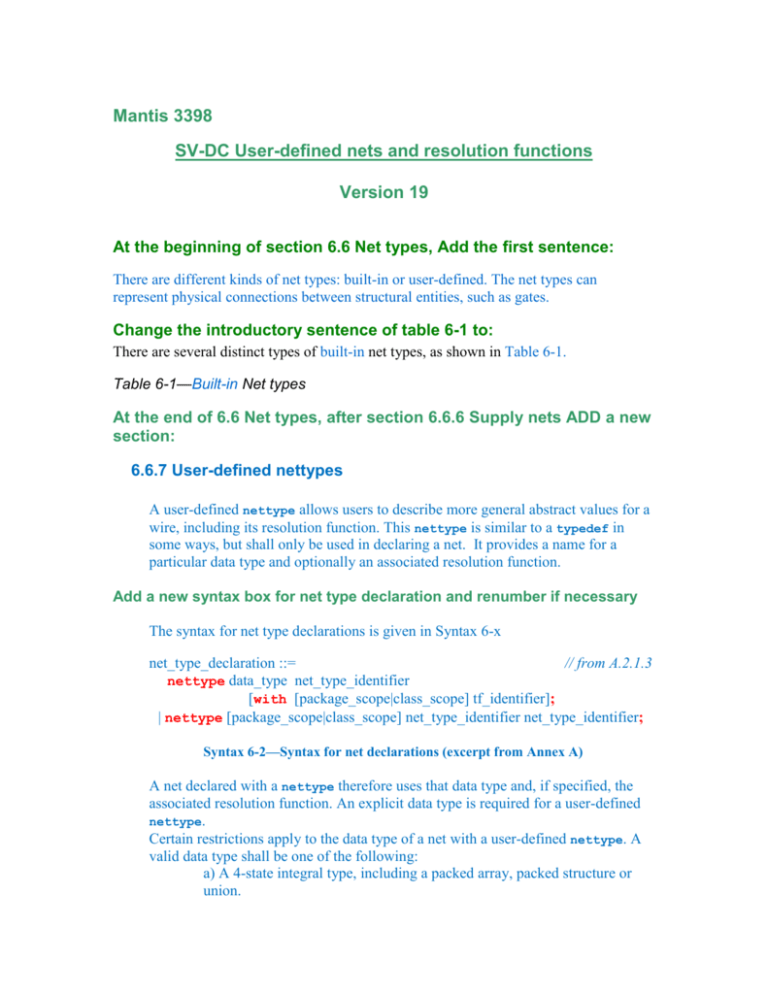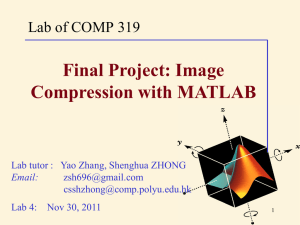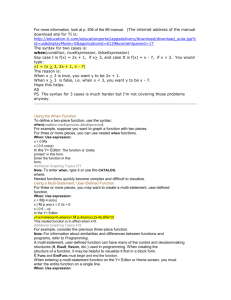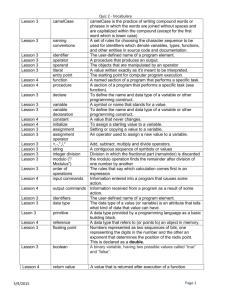3398_UserNettypes_v19
advertisement

Mantis 3398
SV-DC User-defined nets and resolution functions
Version 19
At the beginning of section 6.6 Net types, Add the first sentence:
There are different kinds of net types: built-in or user-defined. The net types can
represent physical connections between structural entities, such as gates.
Change the introductory sentence of table 6-1 to:
There are several distinct types of built-in net types, as shown in Table 6-1.
Table 6-1—Built-in Net types
At the end of 6.6 Net types, after section 6.6.6 Supply nets ADD a new
section:
6.6.7 User-defined nettypes
A user-defined nettype allows users to describe more general abstract values for a
wire, including its resolution function. This nettype is similar to a typedef in
some ways, but shall only be used in declaring a net. It provides a name for a
particular data type and optionally an associated resolution function.
Add a new syntax box for net type declaration and renumber if necessary
The syntax for net type declarations is given in Syntax 6-x
net_type_declaration ::=
// from A.2.1.3
nettype data_type net_type_identifier
[with [package_scope|class_scope] tf_identifier];
| nettype [package_scope|class_scope] net_type_identifier net_type_identifier;
Syntax 6-2—Syntax for net declarations (excerpt from Annex A)
A net declared with a nettype therefore uses that data type and, if specified, the
associated resolution function. An explicit data type is required for a user-defined
nettype.
Certain restrictions apply to the data type of a net with a user-defined nettype. A
valid data type shall be one of the following:
a) A 4-state integral type, including a packed array, packed structure or
union.
b) A 2-state integral type, including a packed array, packed structure or
union with 2-state data type members.
c) A real or shortreal type.
d) A fixed-size unpacked array, unpacked structure or union, where each
element has a valid data type for a net of a user-defined nettype.
A second form of a nettype declaration is to create another name for an existing
nettype.
An atomic net is a net whose value is updated and resolved as a whole. A net
declared with a user-defined nettype is an atomic net. Similarly, a logic net is an
atomic net but a logic vector net is not an atomic net as each logic element is
resolved and updated independently. While an atomic net may have a singular or
aggregate value, each atomic net is intended to describe a single connection point in
the design.
The resolution for a user-defined nettype is specified using a SystemVerilog
function declaration. If a resolution function is specified, then when a driver of the
net changes value, an update event is scheduled on the net in the Active (or
Reactive) region. When the update event matures, the simulator calls the resolution
function to compute the value of the net from the values of the drivers. The return
type of the function shall match the data type of the nettype. The function shall
accept an arbitrary number of drivers, since different instances of the net could be
connected to different numbers of drivers. Any change in the value of one or more
of the drivers shall trigger the evaluation of the resolution function associated with
that nettype.
A user-defined resolution function for a net of a user-defined nettype with a data
type T shall be a function with a return type of T and a single input argument
whose type is a dynamic array of elements of type T. A resolution function shall be
automatic (or preserve no state information) and have no side effects. A resolution
function shall not resize the dynamic array input argument nor shall it write to any
part of the dynamic array input argument. While a class function method may be
used for a resolution function, such functions shall be class static methods as the
method call occurs in a context where no class object is involved in the call.
Parameterized variants of such methods can be created through the use of
parameterized class methods as described in 13.8. [Note to editor: 13.8 is a new
section in Mantis 696 and should be integrated first; any change to that
section number should be reflected here.]
Two different nettypes can use the same data type, but have different resolution
functions A nettype may be declared without a resolution function, in which case
it shall be an error for a net of that nettype to have multiple drivers.
Due to non-determinism within scheduling regions, if there are multiple driver
updates within a scheduling region, there may be multiple evaluations of the
resolution function.
A force statement can override the value of a net of a user-defined nettype. When
released, the net returns to the resolved value.
// user-defined data type T
typedef struct {
real field1;
bit field2;
} T;
// user-defined resolution function Tsum
function automatic T Tsum(input T driver[]);
Tsum.field1 = 0.0;
foreach (driver[i])
Tsum.field1 += driver[i].field1;
endfunction
nettype T wT; // an unresolved nettype wT whose data type is T
// a nettype wTsum whose data type is T and
// resolution function is Tsum
nettype T wTsum with Tsum;
// user-defined data type TR
typedef real TR[5];
// an unresolved nettype wTR whose data type
// is an array of real
nettype TR wTR;
// declare another name nettypeid2 for nettype wTsum
nettype wTsum nettypeid2;
The following example shows how to use a combination of a parameterized class
definition with class static methods to parameterize the data type of a user-defined
nettype.
class Base #(parameter p = 1);
typedef struct {
real r;
bit[p-1:0] data;
} T;
static function T Tsum(input T driver[]);
Tsum.r = 0.0;
Tsum.data = 0;
foreach (driver[i])
Tsum.data += driver[i].data;
Tsum.r = $itor(Tsum.data);
endfunction
endclass
typedef Base#(32) MyBaseT;
nettype MyBaseT::T narrowTsum with MyBaseT::Tsum;
typedef Base#(64) MyBaseType;
nettype MyBaseType::T wideTsum with MyBaseType::Tsum;
narrowTsum net1;
wideTsum net2;
// data is 32 bits wide
// data is 64 bits wide
In 6.7, 10.3 and A.2.1.3, CHANGE FROM:
net_declaration ::=
net_type [drive_strength | charge_strength] [vectored | scalared]
data_type_or_implicit [delay3] list_of_net_decl_assignments;
TO:
net_declaration ::=
net_type [drive_strength | charge_strength] [vectored | scalared]
data_type_or_implicit [delay3] list_of_net_decl_assignments;
| net_type_identifier [ delay_control ]
list_of_net_decl_assignments;
In section 6.7 Net declaration, below the syntax table 6-1
Change:
Net declarations without assignments are described in this clause.
To:
Net declarations without assignments and whose nettype is not a user-defined
nettype are described in this clause.
At the end of 6.7 Net declaration, ADD 2 new sections
6.7.1 Net Declaration with user-defined nettype
A net with a user-defined nettype allows users to describe more general abstract
values for a wire. A net declared with a nettype uses the data type and any
associated resolution function for that nettype.
// an unresolved nettype wT whose data type is T
// Refer to example in section 6.6.7 for declaration of the data type T
nettype T wT;
// a nettype wTsum whose data type is T and
// resolution function is Tsum
// Refer to example in section 6.6.7 for the declaration of Tsum
nettype T wTsum with Tsum;
// a net of unresolved nettype wT
wT w1;
// an array of nets, each net element is of unresolved nettype wT
wT w2[8];
// a net of resolved nettype wTsum and resolution function Tsum
wTsum w3;
// an array of nets, each net is of resolved nettype wTsum
wTsum w4[8];
// user-defined data type TR which is an array of reals
typedef real TR[5];
// an unresolved nettype wTR with data type TR
nettype TR wTR;
// a net with unresolved nettype wTR and data type TR
wTR w5;
// an array of nets, each net has an unresolved nettype wTR
// and data type TR
wTR w6[8];
6.7.2 Initialization of nets with user-defined nettypes
The resolution function for any net of a user-defined nettype shall be activated at
time zero at least once. This activation occurs even for such nets with no drivers
or no value changes on drivers at time zero. Since the actual evaluation of the
resolution function is subject to scheduling non-determinism, no assumptions can
be made regarding the state of driven values during the guaranteed call, which
may precede or follow any driver changes at time zero.
The initial value of a net with a user-defined nettype shall be set before any
initial or always procedures are started and before the activation of the guaranteed
time zero resolution call. The default initialization value for a net with a userdefined nettype shall be the default value defined by the data type. Table 6-7
defines the default value for data types of variables if no initializer is provided,
those default values shall also apply to nets of user defined nettypes for valid data
types of a net. For a net with a user-defined nettype whose data type is a struct
type, any initialization expressions for the members within the struct shall be
applied.
At the end of 7.2.2 Assigning to structures, modify:
The initial assignment expression within a data type shall be ignored when using a data
type to declare a net that does not have a user-defined nettype (see 6.7).
In 6.22 Type compatibility, add new section:
6.22.6 Matching nettypes
a) A nettype matches itself and the nettype of nets declared using that
nettype within the scope of the nettype type identifier.
b) A simple nettype that renames a user-defined nettype matches that userdefined nettype within the scope of the nettype identifier.
// declare another name nettypeid2 for nettype nettypeid1
nettype nettypeid1 nettypeid2;
At the end of 7.2.2 Assigning to structures, CHANGE:
The initial assignment expression within a data type shall be used for atomic nets
(see 6.6.7 and 6.7.1) but shall be ignored when using a data type to declare a nonatomic net (see 6.7).
In 10.3.2 The continuous assignment statement, Add a new
paragraph:
Nets can be driven by multiple continuous assignments or by a mixture of
primitive outputs, module outputs, and continuous assignments. Variables can
only be driven by one continuous assignment or by one primitive output or
module output. It shall be an error for a variable driven by a continuous
assignment or output to have an initializer in the declaration or any procedural
assignment. See also 6.5.
A continuous assignment to an atomic net shall not drive part of the net; the entire
nettype value shall be driven. Thus the left-hand side of a continuous assignment
to a net of a user-defined nettype shall not contain any indexing or select
operations into the data type of the nettype.
At the end of 10.3.3 Continuous assignment delays, (add a new
paragraph):
If the left-hand references a vector net, then up to three delays can be applied. The
following rules determine which delay controls the assignment:
- If the right-hand side makes a transition from nonzero to zero, then the
falling delay shall be used.
- If the right-hand side makes a transition to z, then the turn-off delay
shall be used.
- For all other cases, the rising delay shall be used.
If the left-hand side references a net of a user-defined nettype or an array of such
nets then only a single delay may be applied. The specific delay is used when any
change occurs to the value of the net.
In section 10.6.2 The force and release procedural statements, modify
The left-hand side of the assignment can be a reference to a singular variable, a
net, a constant bit-select of a vector net, a constant part-select of a vector net, or a
concatenation of these. It shall not be a bit-select or a part-select of a variable or
of a net with a user-defined nettype.
In 23.3.3 Port connection rules, ADD at the end:
If the internal and external connections to a port are of user-defined nettypes, they
shall be of matching nettypes and shall be merged into a single simulated net. If
only one of the two connections is of a user-defined nettype then the connections
shall have matching data types, the port shall be of mode input or output and the
connection shall be treated as a continuous assignment from source to sink.
In 23.3.3.3, CHANGE CLAUSE TITLE TO:
23.3.3.3 Port connection rules for nets with built-in nettypes
In 28.12 Strengths and values of combined signals, immediately
before 28.12.1 Combined signals of unambiguous strength (ADD a
new sentence):
In addition to a signal value, a net shall have either a single unambiguous strength
level or an ambiguous strength consisting of more than one level. When signals
combine, their strengths and values shall determine the strength and value of the
resulting signal in accordance with the principles in 28.12.1 through 28.12.4. Nets
with user-defined nettypes shall not have strength levels.
Combining signal values for nets with user-defined nettypes shall follow the rules
in 6.6.7 (Resolution of nets with user-defined nettypes). Any strength associated
with any drivers of a net with a user-defined nettype shall be ignored.
In Annex, A.2.1.3 Type declarations,
ADD net_type_declaration in the production for
data_declaration:
data_declaration9 ::=
[ const ] [ var ] [ lifetime ] data_type_or_implicit list_of_variable_decl_assignments ;
| type_declaration
| package_import_declaration10
| virtual_interface_declaration
| net_type_declaration
ADD after type_declaration production:
type_declaration ::= …….
net_type_declaration ::=
nettype data_type net_type_identifier
[with [package_scope|class_scope] tf_identifier];
| nettype [package_scope|class_scope] net_type_identifier net_type_identifier;
In Annex, A.9.3 Identifiers, ADD:
net_type_identifier ::= identifier
In Annex A.2.2.1 Net and variable types, CHANGE:
net_port_type ::=
[net_type]_data_type_or_implicit
to:
net_port_type ::=
[net_type]_data_type_or_implicit
| net_type_identifier
In Table B.1 – Reserved keywords, ADD:
nettype









